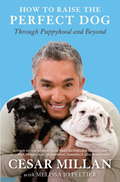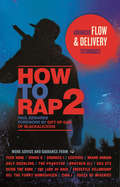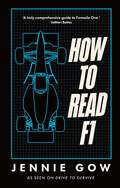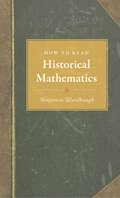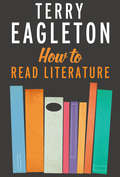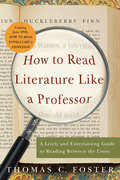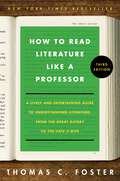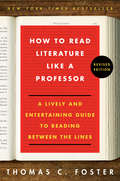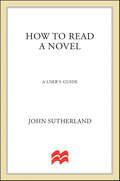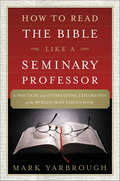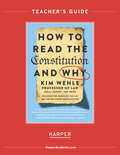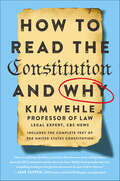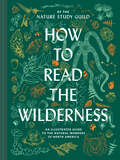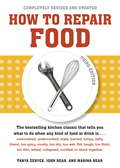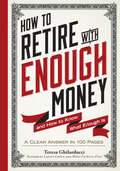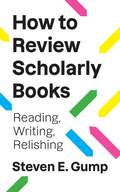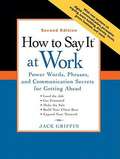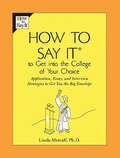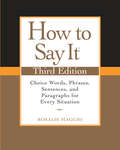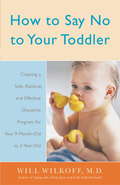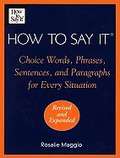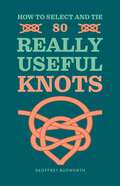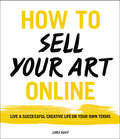- Table View
- List View
How to Raise the Perfect Dog: Through Puppyhood and Beyond
by Cesar Millan Melissa Jo PeltierFrom the bestselling author and star of National Geographic Channel's Dog Whisperer, the only resource you’ll need for raising a happy, healthy dog. For the millions of people every year who consider bringing a puppy into their lives–as well as those who have already brought a dog home–Cesar Millan, the preeminent dog behavior expert, says, "Yes, you can raise the perfect dog!" It all starts with the proper foundation in the early years. Here, Cesar tells you everything you need to know to create the best environment for a well-balanced dog in order to avoid behavior issues in the future, and shows you how to correct the most common behavior issues for young dogs. Based on Cesar’s own detailed experiences raising individual puppies from some of the most popular breeds, How to Raise the Perfect Dog is like having Cesar right beside you, as your own personal expert, coaching you and your dog from the first day of your life together. Packed with new information aimed specifically at the particular needs of puppies and adolescents, and written in Cesar's friendly, accessible style, How to Raise the Perfect Dog answers all the most commonly asked questions and guides you towards a loving, satisfying life-long relationship with your best friend. #1 New York Times bestselling author, Cesar Millan shows you how to raise the perfect dog and prevent behavior issues before they start, including:• what to expect from each stage of your puppy's development• quick and easy housebreaking• the essentials of proper nutrition• the importance of vaccinating–and of not over-vaccinating• creating perfect obedience from day one through rules, boundaries, and calm-assertive leadership• how to avoid the most common mistakes owners make raising puppies and young dogs• how to correct any issue before it becomes a problem• unique exercises and play to bring out the best in every breedFrom the Hardcover edition.
How to Rap 2: Advanced Flow and Delivery Techniques
by Paul Edwards Gift Of GabIn this sequel to How to Rap, techniques that have not previously been explained--such as triplets, flams, lazy tails, and breaking rhyme patterns--are thoroughly broken down and examined, arming readers with additional tools for their rapping repertoire. Filled with interviews from hip-hop's most innovative artists, including Tech N9ne, Crooked I, Pharcyde, Das EFX, Del the Funky Homosapien, and Big Daddy Kane, this book takes you through the intricacies of rhythm, rhyme, and vocal delivery, delving into the art form in unprecedented detail. This work is a must-read for MCs looking to take their craft to the next level, as well as anyone fascinated by rapping and its complexity.
How to Read F1: Everything you need to know about racing in the fast lane
by Jennie Gow'Formula 1 is as complex as it is competitive, existing in a world which has built up a language almost unique to itself. Jennie has been working the Formula 1 pitlanes and paddocks of the world since before many of today’s superstars had even started karting. She knows the sport inside out. There’s nobody better to take you on this alphabetic adventure through the greatest sport in the world.' Will Buxton'This is a great read for old and new fans of F1, one that will inform, educate and entertain you. A truly comprehensive guide to Formula One - from A to Z (and most importantly, to B).' Valtteri Bottas'Jennie's job is to go where angels fear to tread. Being in the pit lane and on the grid or even in the F1 paddock is not for the faint of heart. It takes courage and a lot of hard work to know your stuff and ask the difficult questions in F1. Jennie Gow is that gal!' – Damon Hill'Jennie brings such a great passion to broadcasting on F1.' – Nico RosbergFun, informative and insightful, How to Read F1 is the perfect gift for Formula One fans.BBC F1 presenter and Drive to Survive expert Jennie Gow covers the key concepts, drivers, teams, tech and rules in an easy-to-read, bitesize format. Featuring bespoke illustrations capturing the sport's famous faces and technical elements, the book is packed with Jennie's unique insights, anecdotes and plenty of trivia. Whether you’re new F1 and keen to learn more or a veteran supporter looking to brush up on facts, there’s something for everyone in this entertaining guide to racing in the fast lane.
How to Read Historical Mathematics
by Benjamin WardhaughTechniques for deciphering texts by early mathematiciansWritings by early mathematicians feature language and notations that are quite different from what we're familiar with today. Sourcebooks on the history of mathematics provide some guidance, but what has been lacking is a guide tailored to the needs of readers approaching these writings for the first time. How to Read Historical Mathematics fills this gap by introducing readers to the analytical questions historians ask when deciphering historical texts.Sampling actual writings from the history of mathematics, Benjamin Wardhaugh reveals the questions that will unlock the meaning and significance of a given text—Who wrote it, why, and for whom? What was its author's intended meaning? How did it reach its present form? Is it original or a translation? Why is it important today? Wardhaugh teaches readers to think about what the original text might have looked like, to consider where and when it was written, and to formulate questions of their own. Readers pick up new skills with each chapter, and gain the confidence and analytical sophistication needed to tackle virtually any text in the history of mathematics.Introduces readers to the methods of textual analysis used by historiansUses actual source material as examplesFeatures boxed summaries, discussion questions, and suggestions for further readingSupplements all major sourcebooks in mathematics historyDesigned for easy referenceIdeal for students and teachers
How to Read Literature
by Terry EagletonWhat makes a work of literature good or bad? How freely can the reader interpret it? Could a nursery rhyme like Baa Baa Black Sheep be full of concealed loathing, resentment, and aggression? In this accessible, delightfully entertaining book, Terry Eagleton addresses these intriguing questions and a host of others. How to Read Literature is the book of choice for students new to the study of literature and for all other readers interested in deepening their understanding and enriching their reading experience.In a series of brilliant analyses, Eagleton shows how to read with due attention to tone, rhythm, texture, syntax, allusion, ambiguity, and other formal aspects of literary works. He also examines broader questions of character, plot, narrative, the creative imagination, the meaning of fictionality, and the tension between what works of literature say and what they show. Unfailingly authoritative and cheerfully opinionated, the author provides useful commentaries on classicism, Romanticism, modernism, and postmodernism along with spellbinding insights into a huge range of authors, from Shakespeare and J. K. Rowling to Jane Austen and Samuel Beckett.
How to Read Literature Like a Professor
by Thomas C. FosterWhat does it mean when a fictional hero takes a journey?. Shares a meal? Gets drenched in a sudden rain shower? Often, there is much more going on in a novel or poem than is readily visible on the surface--a symbol, maybe, that remains elusive, or an unexpected twist on a character--and there's that sneaking suspicion that the deeper meaning of a literary text keeps escaping you.In this practical and amusing guide to literature, Thomas C. Foster shows how easy and gratifying it is to unlock those hidden truths, and to discover a world where a road leads to a quest; a shared meal may signify a communion; and rain, whether cleansing or destructive, is never just rain. Ranging from major themes to literary models, narrative devices, and form, How to Read Literature Like a Professor is the perfect companion for making your reading experience more enriching, satisfying, and fun.
How to Read Literature Like a Professor 3E: A Lively and Entertaining Guide to Understanding Literature, from The Great Gatsby to The Hate You Give
by Thomas C FosterThoroughly revised and expanded for a new generation of readers, this classic guide to enjoying literature to its fullest—a lively, enlightening, and entertaining introduction to a diverse range of writing and literary devices that enrich these works, including symbols, themes, and contexts—teaches you how to make your everyday reading experience richer and more rewarding. While books can be enjoyed for their basic stories, there are often deeper literary meanings beneath the surface. How to Read Literature Like a Professor helps us to discover those hidden truths by looking at literature with the practiced analytical eye—and the literary codes—of a college professor.What does it mean when a protagonist is traveling along a dusty road? When he hands a drink to his companion? When he’s drenched in a sudden rain shower? Thomas C. Foster provides answers to these questions as he explores every aspect of fiction, from major themes to literary models, narrative devices, and form. Offering a broad overview of literature—a world where a road leads to a quest, a shared meal may signify a communion, and rain, whether cleansing or destructive, is never just a shower—he shows us how to make our reading experience more intellectually satisfying and fun.The world, and curricula, have changed. This third edition has been thoroughly revised to reflect those changes, and features new chapters, a new preface and epilogue, as well as fresh teaching points Foster has developed over the past decade. Foster updates the books he discusses to include more diverse, inclusive, and modern works, such as Angie Thomas’s The Hate U Give; Emily St. John Mandel’s Station Eleven; Neil Gaiman’s Neverwhere; Elizabeth Acevedo’s The Poet X; Helen Oyeyemi's Mr. Fox and Boy, Snow, Bird; Sandra Cisneros’s The House on Mango Street; Zora Neale Hurston’s Their Eyes Were Watching God; Maggie O’Farrell’s Hamnet; Madeline Miller’s Circe; Pat Barker’s The Silence of the Girls; and Tahereh Mafi’s A Very Large Expanse of Sea.
How to Read Literature Like a Professor Revised: A Lively and Entertaining Guide to Reading Between the Lines
by Thomas C. FosterA thoroughly revised and updated edition of Thomas C. Foster's classic guide--a lively and entertaining introduction to literature and literary basics, including symbols, themes, and contexts--that shows you how to make your everyday reading experience more rewarding and enjoyable.While many books can be enjoyed for their basic stories, there are often deeper literary meanings interwoven in these texts. How to Read Literature Like a Professor helps us to discover those hidden truths by looking at literature with the eyes--and the literary codes--of the ultimate professional reader: the college professor.What does it mean when a literary hero travels along a dusty road? When he hands a drink to his companion? When he's drenched in a sudden rain shower? Ranging from major themes to literary models, narrative devices, and form, Thomas C. Foster provides us with a broad overview of literature--a world where a road leads to a quest, a shared meal may signify a communion, and rain, whether cleansing or destructive, is never just a shower--and shows us how to make our reading experience more enriching, satisfying, and fun.This revised edition includes new chapters, a new preface, and a new epilogue, and incorporates updated teaching points that Foster has developed over the past decade.
How to Read a Novel: A User's Guide
by John Sutherland"Do we still know how to read a novel?" John Sutherland, Chairman of the 2005 Booker Prize Committee, asks. His disheartened answer is an unequivocal, "No." But Sutherland has not given up hope. With acerbic wit and intellect, he traces the history of what it used to mean to be well-read and tells readers what it still means today. Using this delightful book as a means to an end, he reminds readers how the delicate charms of fiction can be at once wonderful and inspired and infuriating. On one level this is a book about novels: how they work, what they're about, what makes them good or bad, and how to talk about them. At a deeper level, this is a book in which one of the most intimate tête-à-têtes is described—one in which a reader meets a novel. Will a great love affair begin? Will the rendezvous end in disappointment? Who can say? In order for the relationship to take its appropriate course all the details must be clearly acknowledged and understood for their complexities: plot, point of view, character, style, pace, first and last sentences, and even beauty. Still, Sutherland knows a true understanding of fiction is more than a flirtation with text and style—it is a business. Taking his readers on a trip to the bookshop, he helps them judge a book by its cover based on design and color, wondering aloud what genre might be best, even going so far as to analyze one of the latest American bestsellers to further help the buying reader choose the novel that is right for him or her. In a book that is as wry and humorous as it is learned and opinionated, John Sutherland tells you everything you always wanted to know about how to read fiction better than you do now (but, were afraid to ask).
How to Read the Bible Like a Seminary Professor: A Practical and Entertaining Exploration of the World's Most Famous Book
by Mark YarbroughMany people admire and even revere the Bible, but they simply do not understand what they read, much less how to study Scripture. Yet they wish they could. In this insightful and alternately amusing guide, Professor Mark Yarbrough shows how easy and gratifying it is to unlock the hidden truths of God's Word and to discover a world where reading the Bible doesn't just satisfy our curiosity, but changes our life. To do this, the reader will step into the seminary classroom and observe the practical principles-the tricks of the trade-for becoming a more effective student of the Bible. But Yarbrough has made sure that his writing style and general approach will be appealing to both academic students and those involved in lay-level Bible study. Real life is whacky and in-your-face. Studying Scripture should be too.
How to Read the Constitution--and Why Teaching Guide (Legal Expert Series)
by Kim WehleAn insightful, urgent, and perennially relevant handbook that lays out in common sense language how the United States Constitution works, and how its protections are eroding before our eyes—essential reading for anyone who wants to understand and parse the constantly breaking news about the backbone of American government.The Constitution is the most significant document in America. But do you fully understand what this valuable document means to you? In How to Read the Constitution and Why Now, legal expert and educator Kimberly Wehle spells out in clear, simple, and common sense terms what is in the Constitution, and most importantly, what it means. In compelling terms, she describes how the Constitution’s protections are eroding—not only in express terms but by virtue of the many legal and social norms that no longer shore up its legitimacy—and why every American needs to heed to this “red flag” moment in our democracy.This invaluable—and timely—resource covers nearly every significant aspect of the Constitution, from the powers of the President and how the three branches of government are designed to hold each other accountable, to what it means to have individual rights—including free speech, the right to bear arms, the right to be free from unreasonable searches and seizures, and the right to an abortion. Finally, the book explains why it has never been more important than now for all Americans to know how our Constitution works—and why, if we don’t step in to protect it now, we could lose its protections forever.How to Read the Constitution and Why Now is essential reading for anyone who cares about maintaining an accountable government and the individual freedoms that the Constitution enshrines for everyone in America—regardless of political party.
How to Read the Constitution—and Why (Legal Expert Series)
by Kim Wehle“A must-read for this era” that lays out in common sense language how the US Constitution works, and how its protections are eroding before our eyes (Jake Tapper, CNN Anchor and Chief Washington Correspondent).The Constitution is the most significant document in America. But do you fully understand what it means to you? In How to Read the Constitution—and Why, legal expert and educator Kimberly Wehle spells out in clear, simple, and common-sense language what is in the Constitution, and most importantly, what it means. In compelling terms and including text from the United States Constitution, she describes how its protections are eroding—not only in express terms but by virtue of the many legal and social norms that no longer shore up its legitimacy—and why every American needs to heed to this “red flag” moment.This invaluable—and timely—resource includes the Constitution in its entirety and covers nearly every significant aspect of the text, from the powers of the President and how the three branches of government are designed to hold each other accountable, to what it means to have individual rights—including free speech, the right to bear arms, the right to be free from unreasonable searches and seizures, and the right to an abortion. Finally, the book explains why it has never been more important than now for all Americans to know how our Constitution works—and why, if we don’t step in to protect it, we could lose its protections forever.How to Read the Constitution—and Why is essential reading for anyone who cares about maintaining an accountable government and the individual freedoms that the Constitution enshrines for everyone in America—regardless of political party.
How to Read the Wilderness: An Illustrated Guide to North American Flora and Fauna
by Nature Study GuildThis book invites you to see the natural world in all its intricacy and intense beauty and become a knowledgeable steward of the wild.From the mountains to the ocean shores, from the wetlands to the deserts, North America teems with flora and fauna in delicately balanced ecosystems found nowhere else on Earth. With this book in hand, you will understand the language of nature and see those wild places with new eyes. You'll learn to recognize the lobed leaf of an Oracle Oak, the webbed tracks of a River Otter, and the fine, cream-colored tentacles of a Frilled Anemone. This volume celebrates a tradition of knowledge established by the Nature Study Guild. For more than sixty years, the Guild's pocket guidebooks have helped hikers, campers, foragers, and explorers navigate the great outdoors. Now, the best of the guides' informative text and iconic illustrations are gathered in one handsome hardcover: the perfect reference for today's ramblers.FOR NATURE LOVERS OLD AND NEW: More and more people are invested in and curious about the natural world—from avid campers and hikers to those worried about climate change. This book, with its celebratory tone and charming vintage style, will appeal to anyone who cherishes the natural world.NOSTALGIC APPEAL: The classic nature illustration style evokes memories of learning about flora and fauna in childhood, making this a wonderfully nostalgic gift.BEAUTIFUL BLEND OF ART AND SCIENCE: This volume presents detailed scientific information in a gorgeous package, a deluxe hardcover that will grace coffeetables and bookshelves. It makes a perfect gift for anyone interested in biology or illustration (or both!).Perfect for:Nature loversHikers, campers, and foragersEnvironmentalistsScientists and science studentsTeachers and parentsFans of vintage illustrationArtists
How to Repair Food
by John Bear Tanya Zeryck Marina BearTHE BEST-LAID PLANS OFTEN GO AWRY ... especially in the kitchen. When you're faced with one of those inevitable cooking calamities--be it a sinking souffle, salty soup, or stuck-together pasta--How to Repair Food has the answers and advice you need to get your meal back on track. First published in 1970 and now with more than 100,000 copies in print, this kitchen classic has been completely revised and updated to serve a new generation of home cooks. NEW TO THE THIRD EDITION: " Hints on lowering fat and sodium. " Ways to integrate wholesome and organic ingredients. " Tips for reducing kitchen waste. " Ideas for coping with holiday and other special-occasion dinner debacles. Filled with witty, accessible, and often ingenious solutions to mishaps that befall even the best of cooks, the alphabetical listings (from Abalone to Zucchini) are designed to rescue any dish from the brink of disaster.
How to Retire with Enough Money: And How to Know What Enough Is
by Teresa GhilarducciHere is a single-sit read than can change the course of your retirement. Written by Dr. Teresa Ghilarducci, an economics professor, a retirement and savings specialist, and a trustee to two retiree health-care trusts worth over $54 billion, How to Retire with Enough Money cuts through the confusion, misinformation, and bad policy-making that keeps us spending or saving poorly. It begins with acknowledging what a person or household actually needs to have saved—the rule of thumb is eight to ten times your annual salary before retirement—and how much to expect from Social Security. And then it delivers the basic principles that will make the money grow, including a dozen good ideas to get current expenses under control. Why to “get rid of your guy”—those for-fee (or hidden-fee) financial planners that suck up valuable assets. Why it’s always better to pay off a loan or a mortgage. There are no gimmicks, no magical thinking—just an easy-to-follow program that works.
How to Review Scholarly Books: Reading, Writing, Relishing (Skills for Scholars)
by Steven E. GumpA guide to the art of reviewing scholarly books, with strategies and suggestionsScholarly book reviews should be enjoyable—both to write and to read. All too often, though, they offer little more than chapter-by-chapter summaries. In this comprehensive handbook, Steven Gump offers an encouraging guide to crafting valuable reviews of scholarly books in the humanities and social sciences. Readers learn how to write engaging, respectful reviews that make intellectual contributions of their own. With extensive experience in both writing and editing scholarly book reviews, Gump walks prospective reviewers through the process of selecting a book to review, identifying a venue to publish the review, reading and annotating the book, and writing a review that is tailored to the audience of the target venue, with the possibility of dissemination to popular outlets beyond the core field.Alongside this practical advice, Gump offers a generous philosophy of scholarly book reviewing that considers the roles of book reviews and the responsibilities of book reviewers within the broader scholarly ecosystem. Readers learn how to uplift the voices and contributions of authors, how to prepare the next generation of reviewers (including undergraduates or graduate students), and how to elevate an unjustly underestimated genre. Ultimately, this essential guide brings into renewed focus the joys of reading scholarly works, engaging with intellectual ideas, and writing incisively.
How to Say It at Work, Second Edition
by Jack GriffinA fully revised edition of the bestselling communication tool.This revised edition includes new advice on the latest developments in the workplace since the book?s initial publication ten years ago. Along with a new chapter on digital communication, each original chapter includes a discussion of topics such as diversity issues, team building, green business, and more. In addition, the revision includes a new chapter on the art of the effective argument, with a step-by step emphasis on building a persuasive case and acquiring the skills necessary for disagreeing without being disagreeable.
How to Say It to Get Into the College of Your Choice
by Linda MetcalfThe latest in the How to Say It(r) series demystifies the omplex college admissions process. How to Say It(r) to Get Into the College of Your Choice offers students-as well as their parents and school counselors-a variety of essential resources and information, including: - Worksheets for writing personal statements and resumes - Winning words and phrases for filling out a sample Common Application used by more than 200 of the top colleges - Finding the right words for the admissions essay-using advice from admissions directors at top schools - Pointers for the essay portion of the New SAT- plus a practice test - The fundamentals of obtaining winning recommendations - Statements to make interviews successful .
How to Say It, Third Edition
by Rosalie Maggio"For anyone who has ever stared at a blank page or screen"(Kaylene Weiser, organized consultant, The Wiser Way)- the revised third edition of the bestseller that offers "a crisp, elegant way to say everything. "(Vivian Jenkins Nelson, founder, The International Institute for Interracial Interaction) The "exceptional, wonderful, amazing"(Vivian Jenkins Nelson, founder, The International Institute for Interracial Interaction) book that has sold nearly one million copies!How to Say It® provides clear and practical guidance for what to say-and what not to say-in any situation. Covering everything from business correspondence to personal letters, this is the perfect desk reference for anyone who often finds themselves struggling to find those perfect words for:* Apologies and sympathy letters* Letters to the editor* Cover letters* Fundraising requests* Social correspondence, including invitations and AnnouncementsThis new edition features expanded advice for personal and business emails, blogs, and international communication.
How to Say It, Third Edition
by Rosalie Maggio?For anyone who has ever stared at a blank page or screen?(Kaylene Weiser, organized consultant, The Wiser Way)? the revised third edition of the bestseller that offers ?a crisp, elegant way to say everything.?(Vivian Jenkins Nelson, founder, The International Institute for Interracial Interaction) The ?exceptional, wonderful, amazing?(Vivian Jenkins Nelson, founder, The International Institute for Interracial Interaction) book that has sold nearly one million copies!How to Say It® provides clear and practical guidance for what to say?and what not to say?in any situation. Covering everything from business correspondence to personal letters, this is the perfect desk reference for anyone who often finds themselves struggling to find those perfect words for: ? Apologies and sympathy letters ? Letters to the editor ? Cover letters ? Fundraising requests ? Social correspondence, including invitations and Announcements This new edition features expanded advice for personal and business emails, blogs, and international communication.
How to Say No to Your Toddler: Creating a Safe, Rational, and Effective Discipline Program for Your 9-Month to 3-Year Old
by William WilkoffTeaching your toddler that “no means no” now can save you both suffering. But how do you say it so that he’ll understand?For many parents of toddlers, saying “no” over and over becomes a mantra for exhaustion. Why is it so difficult to convey the meaning of this tiny word? Because, says pediatrician Will Wilkoff, when it comes to tots, actions speak louder than words. Using very direct and simple guidelines, Dr. Wilkoff shows you how to develop a consistent and effective discipline plan. He explains what can go wrong with time-out and how to overcome obstacles, including your child’s rebelliousness, physical space issues, and your own reluctance. He also presents helpful advice for special situations, such as how to say no at meal times, at grandma’s house, and when your child is sick. Presenting his compassionate and practical approach, Dr. Wilkoff shows how you can respond to the misbehavior of very young children while teaching them self-control that will benefit them throughout their lives. How to Say No to Your Toddler is the ideal guide for any parent who wants to take a more effective approach for raising healthy, happy children.
How to Say it®
by Rosalie MaggioProviding quick and succinct solutions to the most common writing problems, this perfect companion to the "How to Say It" series gives readers all the information they need to write powerful and persuasive prose.
How to Select and Tie 80 Really Useful Knots
by Geoffrey BudworthKnowing how to tie knots can help you in everything from work around the home, camping and fishing trips, and even art and craft projects. This is a comprehensive guide to 80 of the most useful knots for:- Sailing- Camping- Climbing and abseiling- Home and garden- Fishing and outdoor pursuitsHow to Select and Tie 80 Really Useful Knots contains an explanation of the basic terms used relating to knots and ropes, and cordage. From the rolling hitch to the boa knot, every knot is accompanied by clear step-by-step instructions and illustrations, making this a resource you'll turn to time and time again.As well as a comprehensive glossary that explains many common terms, there's an introduction to knots and ropes, cordage, and a potted history of each of the knots.
How to Select and Tie 80 Really Useful Knots
by Geoffrey BudworthKnowing how to tie knots can help you in everything from work around the home, camping and fishing trips, and even art and craft projects. This is a comprehensive guide to 80 of the most useful knots for:- Sailing- Camping- Climbing and abseiling- Home and garden- Fishing and outdoor pursuitsHow to Select and Tie 80 Really Useful Knots contains an explanation of the basic terms used relating to knots and ropes, and cordage. From the rolling hitch to the boa knot, every knot is accompanied by clear step-by-step instructions and illustrations, making this a resource you'll turn to time and time again.As well as a comprehensive glossary that explains many common terms, there's an introduction to knots and ropes, cordage, and a potted history of each of the knots.
How to Sell Your Art Online: Live a Successful Creative Life on Your Own Terms
by Cory HuffAn essential guide for artist that teaches them how to skip the gallery system, find their niche, and connect directly with collectors to profitably sell their art.For years, galleries have acted as gatekeeper separating artists and collectors. But with the explosion of the Internet, a new generation of savvy, independent artists is connecting with buyers and making a substantial living doing what they love.How to Sell Your Art Online shows any artist how to make a successful living from their work. Cory Huff dispels the myth of the starving artist and provides the effective business strategies necessary to make artistic creations pay. He helps individual artists find their niche; outlines the elements essential for an effective website; and provides invaluable advice on e-mail marketing, blogging, social media marketing, and paid advertising--explaining how to tie all these online activities into offline success.Most importantly, he shares the secret to overcoming the biggest challenge artists face when self-marketing: learning how to tell their unique stories. Every artist has a reason for making art, but can't always find the right way to express it. Huff provides exercises artists can use to clarify the intellectual and emotional process behind their art, and teaches them how turn that knowledge into stories they can tell online and in person--and expand their reach through blogs and social media to build their art business.Drawing from the stories of successful artists, thoroughly describing how art is sold today, and providing tips on how to build connections personally and electronically, How to Sell Your Art Online illustrates the countless ways artists can take control of their creative careers--and sell their work without selling out.
